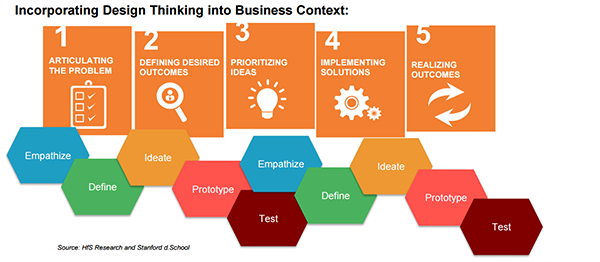In business operations, global shared services, and outsourcing, the mantra has been: centralize, standardize, industrialize, globalize. Traditional shared services and outsourcing contracts have been developed to focus on “lift and shift” and how to make processes increasingly more efficient and effective, measured by service level agreements. But what happens when the SLAs are green but customer or stakeholder satisfaction is level, stale, or down? When you feel that “innovation” is lacking? That the world is shifting to become faster, more flexible, and in-touch—but your business delivery isn’t and you just don’t have the time to think about it?
The answers to those questions are more and more often to use Design Thinking as a catalyst for innovation and continuous change. And it is the reason we explored the integration of Design Thinking into business operations and outsourcing design and delivery. Insights on how Design Thinking plays a role in creating a different experience—a different way of working and new insights for operational excellence and expansion—and 11 service providers are profiled in the recently published HfS Blueprint: Design Thinking in the As-a-Service Economy.
All of the service providers in the blueprint we’ve just published, Design Thinking in the As-a-Service Economy, are increasingly incorporating the principles of Design Thinking—human-centered, collaborative, action-oriented—into the way they work. Just like the increasing attention to robotic process automation and cognitive computing, experimentation has been going on for a while now… and so it is no longer “new” to many of them.
Design Thinking is a complement to, not a replacement for, operational excellence and solutioning for service design and delivery
You can use Design Thinking to understand what’s really causing problems or issues or expenses, by better understanding what people are actually doing –or not—and feeling. What is their experience? And then working through ideas that may revise, or replace, or eliminate process; that may change what people are doing and how; and could use current technology better, or new technology. As one shared services executive told us, “we already know how to make something efficient [with Lean Six Sigma] and we required a new way of thinking in some specific areas.” Along these lines, we are not anticipating an end or replacement to Lean Six Sigma or “operational excellence” but adding a way of stepping outside the process to identify trouble spots and new solutions.
With Design Thinking you focus on understanding who is involved in whatever process or problem you are looking to address, and what are their expectations and needs (the “human” side)? And what is the industry and corporate context, the business outcomes to impact (the “business” side)? And what are the technology enablers? Then bringing it all together in a solution through a series of prototypes and tests. (See Exhibit 1: Incorporating Design Thinking Into Business Context for Shared Services and Outsourcing) Sometimes the solution is a quick fix, like changing the day of the week or where a request from a consumer is directed in a system; and sometimes it will help you identify a new way of working or a new service or solution.
Exhibit 1:

Bottom line: By using Design Thinking, we are moving a more human-centered, business-outcome oriented, and questioning approach to defining and delivering services in consulting and outsourcing, just the way the world is doing in general.
Using Design Thinking “was helpful because we make assumptions about people,” said an insurance executive interviewed in our study. Taking the time to empathize with the end user through interviews and observations “helped us to make sure we understand not just what we do for the consumer but how it makes them feel.” In other words, it’s not just about what you’re doing but the relevance of it to your end user. If you want your customers and your stakeholders to work with you to reach your business outcomes, then look for ways to make it easier for them to do it – and that means understanding them better, and that’s a role that Design Thinking can play.
Where is the outsourcing services industry on the path to integrate Design Thinking?
We want to help you, through our blueprints, to make the right match for a services engagement – short or long term. While that effort used to be about “we as a buyer post a list of requirements and look for cost reduction” and “we as a service provider will tap into our best practices, tell you about our features and functions, and hire or assign people who can process transactions” … times are changing.
Now, engaging a service provider or providing services to a business means understanding the context, the challenges, the outcomes desired, and how to broker and define a solution that can be flexible and change as the market changes. We’ve been calling this movement the “As-a-Service Economy.” Design Thinking can play a role in this movement towards a new way of working as partners. But because it is a new way of working, it does take time – trial and error and willingness to work in a new way. It impacts roles, governance, budgets, and contracts. And equally important, you need to have alignment in the expectations and cultures of the partners involved in order to feel as though this way of working can work – to deliver results.
In the Design Thinking in the As-a-Service Economy Blueprint, we look at the relevance, use and impact of Design Thinking in services engagements as it takes shape as an integral part of business operations and outsourcing solution and service design and delivery. It includes coverage of the following service providers in terms of Design Thinking integration into the way service buyers and service providers are working together: Accenture, Capgemini, Cognizant, Concentrix, EXL, Genpact, Infosys, Sutherland, Tech Mahindra/BIO Agency, Wipro
Posted in : Business Process Outsourcing (BPO), Design Thinking






